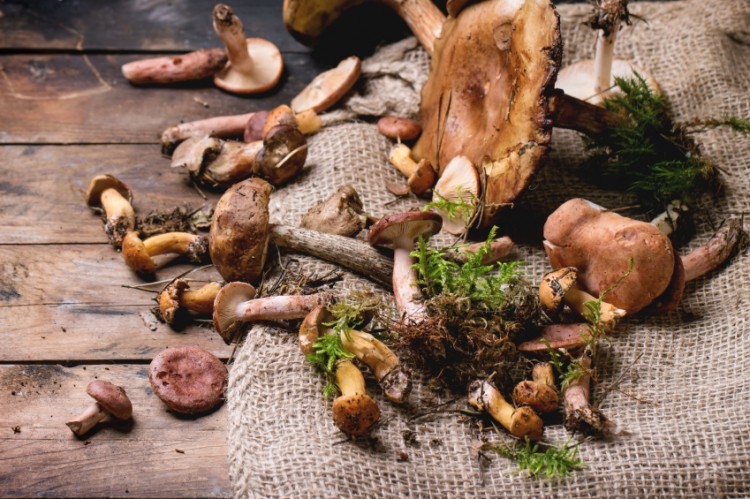‘Most companies understand green herbs, vitamins & minerals, but they don’t understand mushrooms & fungi’: Nammex

Demand for Reishi, Chaga, Shiitake, Maitake, and the rest has never been higher and the global market was pegged at $18 billion in 2014 (up from $6 billion in 1999).
“Over the last five years mushrooms have come into their own,” Chilton told us. “Worldwide the market is in the billions of dollars, especially in Asia.”
But misunderstanding and misinformation affect the market, he said. “The problem is that most companies understand green herbs, vitamins and minerals, but they don’t understand mushrooms and fungi. From a quality standpoint there are problems.”
Mushroom vs mycelium
The issues arise from the difference between a mushroom (the ‘fruiting body’) and mycelium (the ‘vegetative body’). Commercial suppliers can be found for dried mushrooms, mycelium-on-grain products, and mushroom extracts.
“A lot of companies are selling products that are mycelium growing on a grain like oats or rice and they don’t separate this out, so there is residual grain left in the final product” said Chilton. This can mean that the predominant component in these mycelium products is starch, in some cases as high as 60%. “This is a novel and unique product, but it’s not a mushroom. Calling these products mushroom is mislabeling or misbranding these products.”
The regulations concur, with the US Food and Drug Administration stating: “Mushroom mycelium* grown in acceptable media is regarded as suitable for food use. Any food in which mushroom mycelium is used should be labeled to state that fact. Labeling should not suggest or imply that the food contains mushrooms.
“For example, a soup in which mushroom mycelium is an ingredient should not be labeled or sold as "mushroom soup" since that name by long consumer understanding and usage is preempted by soup containing real mushrooms.”
* Chilton said that the use of the term “mushroom mycelium” is a contradiction that even the FDA didn’t see in 1976. “Mushroom and mycelium are different stages or “plant parts” of the fungal organism. It would be like saying apple root; root flower. And to be specific, we are talking about commerce and correct product descriptions.
“However, it is still very prescient that they would have such a policy and the intent is solid and rational.”
Analytical methods
Interest in mushrooms has been growing across multiple categories, with data from SPINS indicating that mushrooms are becoming a popular ingredient for beverages. SPINS data shows surging sales of products with various types of mushrooms as primary ingredients across the natural, specialty and conventional multi-outlet retail channels. Reishi was up 91% for the 52 weeks ending September 4, 2016 versus the previous 52 weeks, while Chaga was up 46%, Cordycep up 19%, and Shiitake up 26%.
The picture was muddied further by a lack of real standards for these products, he said. That was until Megazyme Ireland International developed a method to quantify the beta-(1-3)(1-6)-glucan content of fungal products (Journal of AOAC International, Vol. 99, No. 2, pp. 364-373).
“Finally we have test methods specific to mushrooms and the beta-glucans,” said Chilton. “We have now tested over 200 samples and have a body of data that is unique and of greater depth than any commercial mushroom company. We have established analytical markers that clearly demonstrate the medicinal value of mushroom products and allow Nammex to produce a comprehensive fingerprint.
“The beta-glucan tests offer a great window into the quality of these products.”
“Beta-glucans are the important polysaccharides,” he said. “But starch is also a polysaccharide. Mushrooms contain no starch. That is why a polysaccharide test is of no value, since it also measures the grain starches and carrier starches.”
In June 2016, Chilton presented his research to the International Society for Mushroom Science (ISMS) conference, telling attendees that the beta-glucan content of 22 commercial samples ranged from 25% to 66% for mushrooms, while the content in mycelium-on-grain products was consistently below 10%. On the other hand, alpha-glucan (starch) content in the grain products can range from 24-70%.
“I believe in this category. There is great medicinal value to mushrooms but when consumers are buying products that are more grain than mushroom, that’s a problem,” he told us.
Reaction
“My article in HerbalGram 108 as well as some of our advertising that has focused on labeling issues has stimulated some companies to petition AHPA to get involved in the issue of what is a mushroom and how it is different from mycelium,” explained Chilton.
During the March 9, 2017 meeting of its Board of Trustees, the American Herbal Products Association authorized issuance of guidance for labeling products that contain fungi ingredients. The guidance will be effective in two years (as of March 9, 2019).
"AHPA appreciates our members' interest in providing consumers with the most useful information about fungi ingredients included in this important product category," said AHPA President Michael McGuffin in a statement. "This is another example of the herb and supplement industry taking initiative to best serve consumers' needs and interests."
The main points highlighted in the AHPA guidance are as follows:
"Inclusion of the word “mushroom” is not required on the label and in labeling of a dietary supplement product that consists of or includes fungi dietary ingredients; however, if the word is used then all of the following apply:
- The word “mushroom” may be included in the marketer’s company name wherever located on labels or labelling irrespective of the part(s) of the fungal ingredient(s) contained in the product.
- If the word “mushroom” appears on the label’s principal display panel (PDP) other than in the marketer’s company name and the product contains a single fungal ingredient or more than one fungal ingredient that each consist of the same part of each of the contained fungi, the word is modified on the PDP to identify the part(s) of the fungal dietary ingredient(s) contained in the product; for example “mushroom mycelium,” “mushroom spore,” etc.; except that the fruitbody may be identified with the unmodified word “mushroom” (e.g., “shiitake mushroom” or “Ganoderma lucidum mushroom”).
- If the word “mushroom” appears on the label’s PDP other than in the marketer’s company name and the product contains more than one fungal ingredient consisting of different fungi parts, the word is modified on the PDP with specific terms such as “mushroom mycelia and fruitbodies” or general terms such as “mushroom complex” or “mushroom composite”.
"When such terms are used, however, the specific fungi and/or fungi parts present are disclosed in order of predominance by weight in nutrition labeling under the Supplement Facts heading (e.g., “reishi mushroom composite (mycelium, fruitbody, spores)”)."
Commenting on the AHPA guidance, Chilton told us: “I am encouraged that AHPA has addressed this very important issue and has moved in a direction that will help consumers identify the contents of the mushroom products that they are purchasing. I also hope that businesses who sell mycelium on grain “tempeh” products will now refrain from marketing these products as mushroom. The application of clear “plant part” distinctions is long overdue and brings fungal products up to the standards required of all herbal products.
“However, it is also important that company claims of multiple fungal parts and the use of terms such as “mushroom complex or composite" be supported by actual stated amounts including the grain that is integral to these products. Allowance of these terms still creates an area in which to hide actual contents. My goal is to create a less confusing marketplace where real mushroom products can compete on a level playing field.”









